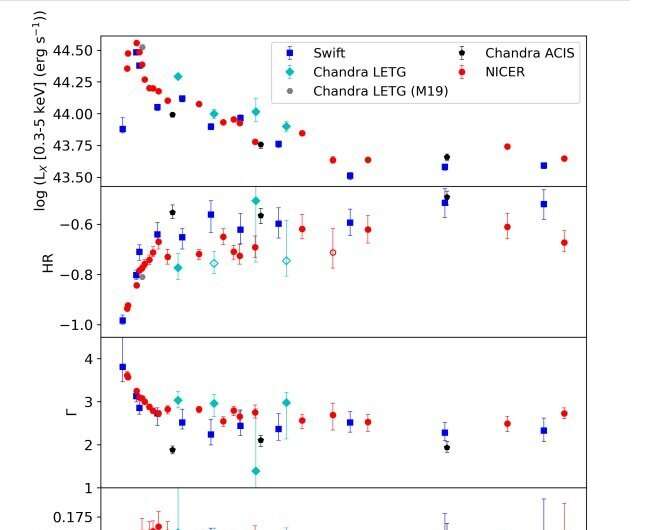May 17, 2022 report
Mysterious nuclear transient AT2019pev inspected in X-rays

Astronomers from the Ohio State University (OSU) and elsewhere have performed a detailed X-ray observational campaign of a mysterious nuclear transient event known as AT2019pev. Results of the study, published May 10 on the arXiv pre-print server, offer more clues into the nature of this peculiar object.
Nuclear astrophysics is key to understanding supernova explosions, and in particular the synthesis of the chemical elements that evolved after the Big Bang. Therefore, investigating nuclear transient events could be essential in order to advance our knowledge in this field.
AT2019pev (other designations: ZTF19abvgxrq and Gaia19eby) is a nuclear transient first reported on September 1, 2019, by the Zwicky Transient Facility (ZTF). The host of this transient was found to be a narrow-line Type I Seyfert galaxy at a redshift of 0.096. Subsequent observations of this transient revealed that it showcased features of tidal disruption events (TDEs) and active galactic nuclei (AGNs).
In order to unveil the true nature of AT2019pev, a team of astronomers led by OSU's Zhefu Yu carried out comprehensive X-ray observations. For this purpose, they used NASA's Swift and Chandra spacecraft, as well as the Neutron star Interior Composition Explorer (NICER) onboard the International Space Station (ISS).
"Although Frederick et al (2021) classified it as an AGN associated transient, they did not provide a detailed analysis of the available Swift X-ray telescope (XRT) data or other available X-ray data. Here we present extensive X-ray observations by Swift, Chandra and NICER over 173 days from the first Swift XRT epoch to further probe the nature of AT2019pev," the researchers explained.
The observations found that the X-ray luminosity of AT2019pev increases by a factor of five in about five days from the first Swift epoch to the peak. Afterward, it decays by a factor of ten with steeper slopes in early epochs and then flattens with a weak re-brightening trend after approximately 105 days.
In general, the X-ray spectra show a "harder-when-brighter" trend before peak and a "harder-when-fainter" trend after peak, which seems to suggest a transition of accretion states. By also analyzing the data from ESA's Gaia satellite, they found that the optical light curve rises toward an equally bright or brighter peak 223 days after the optical discovery and fades when the source is observable again.
All in all, by combining X-ray and multi-wavelength properties of AT2019pev, the astronomers concluded that this transient more closely resembles an active galactic nucleus. They added that evolution of the temporal power-law index of AT2019pev is more consistent with AGNs than TDEs. Moreover, the re-brightening in the UV/optical bands of AT2019pev is natural for AGNs with stochastic variability, although the amplitude is unusual for such sources.
More information: Zhefu Yu et al, An X-ray View of the Ambiguous Nuclear Transient AT2019pev. arXiv:2205.05097v1 [astro-ph.HE], arxiv.org/abs/2205.05097
© 2022 Science X Network





















